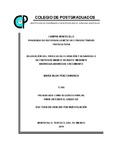Regulación del proceso de floración y desarrollo de frutos de mango 'Ataulfo' mediante biorreguladores de crecimiento.
Abstract
Floración irregular, bajo amarre y alta producción de frutos sin semilla son factores limitantes en la producción de mango ‘Ataulfo’. Los objetivos fueron a) aumentar la productividad de mango ‘Ataulfo’ en Nayarit b) desarrollar tecnologías de producción eficientes y c) tipificar los productores de mango y determinar rentabilidad del cultivo. La investigación se desarrolló de Enero de 2012 a Junio de 2015. Durante 2012-2013 se realizaron experimentos para determinar el tipo de biorregulador, número de aplicaciones y etapa fisiológica más adecuada para aumentar amarre y tamaño de fruto. Durante 2013-2015 se estudió el efecto de inhibidores de crecimiento en el proceso de floración, así como en la expresión de los genes de floración, en este último estudio además el efecto de giberelinas (AG3). Tanto paclobutrazol (PBZ) como prohexadiona de calcio (P-Ca) aceleraron el proceso de iniciación-diferencial floral, lo que condujo a una floración adelantada en 25 y 30 días y mayor porcentaje de floración (87 y 92%). Tidiazuron (TDZ) y AG3 combinados aumentaron el amarre de fruto en Etapa II de crecimiento del fruto y con TDZ en Etapa I y AG3 en Etapa II. Estos resultados estuvieron relacionados con fecundación, al estimular división y un rápido crecimiento de fruto por expansión celular. El mayor tamaño de fruto, menor proporción de frutos partenocárpicos y mayor rendimiento, se obtuvieron con una aplicación de TDZ en Etapa I + tres aplicaciones de AG3 en Etapa II y III lo que se relacionó con el tamaño de la demanda. Se generaron cinco tecnologías y su rentabilidad. El 84% de los productores de mango son en pequeña escala y usan menos tecnología en sus huertos, lo que los hace vulnerables a una baja productividad. _______________ REGULATION OF FLOWERING PROCESS AND FRUITS DEVELOPMENT OF 'ATAULFO' MANGO BY GROWTH BIOREGULATORS. ABSTRACT: Irregular flowering, low fruit setting and high fruit production of seedless fruits are factor that restrict the ‘Ataulfo’ mango production. The aims of this study were a) to increase the ‘Ataulfo’ mango productivity in Nayarit b) to develop efficient production technologies and c) to typify mango growers and to determined crop profitability. The research was conducted in January 2012 to June 2015. During 2012-2013 were determinate the type of bioregulator, number of applications and the best physiological stage to increase fruit setting and size. During 2013-2015 was studied the effect of growth inhibitors in the flowering process, as well as the flowering genes expression and also the effect of gibberellins (AG3). Both paclobutrazol (PBZ) and prohexadione calcium (P-Ca) accelerate the floral initiation-differential process, leading to an early blooming in 25 and 30 days and higher percentage of flowering (87 and 92%). The combination Tiadiazuron (TDZ) and AG3 increased the fruit set in the fruit growing stage II and also with TDZ in stage I and AG3 in stage II. The results were related with fertilization, by stimulating cell division and rapid fruit growth by cell expansion. The larger fruit, the lower proportion of parthenocarpic fruits and higher yield were obtained with the application of TDZ in stage I + three AG3 applications in stage II and stage III, which is relates to the size of demand. Five technologies were generated and its profitability. The 84% of mango growers on a small scale and use less technology in theirs orchards which made them vulnerable to low productivity.
Collections
- Tesis MC, MT, MP y DC [138]


